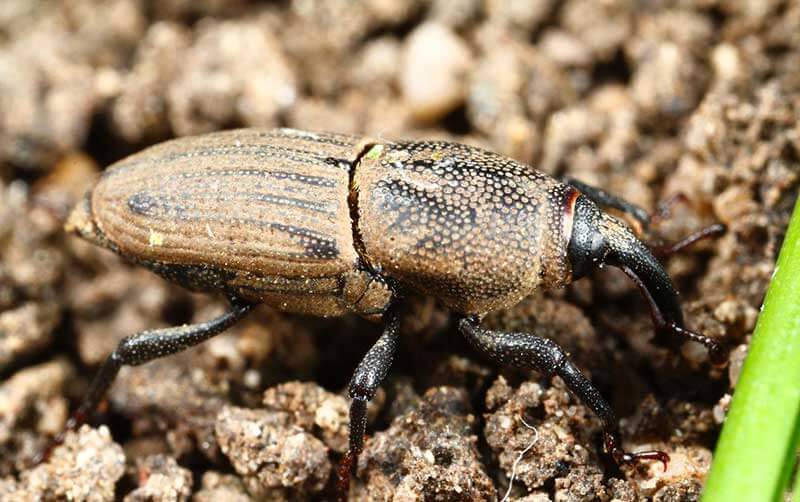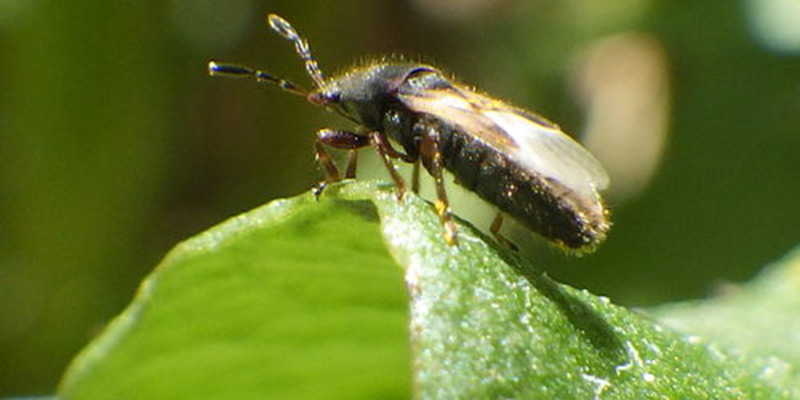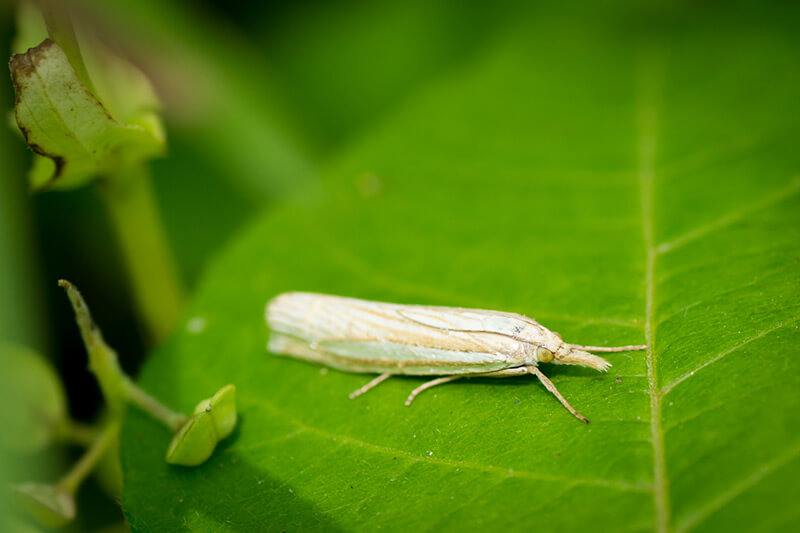Taking On Surface-Feeding Turf Pests
Some turf pests damage lawns from underground, but others do their dirty work at surface level. The destruction often goes overlooked, because it's mistaken for symptoms of drought. But when drought ends and problems don't, homeowners discover that surface-feeders are to blame. These pests share a common target, but they vary in destruction methods and results. Understanding how these pests live and feed can help you defend your turf.
CROWN-FEEDING BILLBUGS
Pests that feed on grass crowns — the areas of turf where grass stems meet roots and growth originates — are especially destructive. Several species of billbugs, also known as “snout beetles," cause severe turf damage, but bluegrass billbugs are major crown-feeding offenders. Adult billbugs are fond of sunning on warm days and have chewing mouthparts at end of long, bill-like snouts. Usually grayish-black and near 3/8 inch long, bluegrass billbugs have grooved, shield-like wings. Adults don't do much damage — but their larvae do.
Bluegrass billbugs overwinter as adults in soil cracks, thatch or plant debris. They mobilize when spring temperatures reach 60 degrees Fahrenheit. Females feed on grass, leaving eggs behind in feeding holes. One female can lay 200 or more eggs per season.1 Eggs can hatch in just six days, and larvae start feeding on the insides of grass stems. They tunnel down, outgrow stems, and drop to the ground, feeding on crowns and uppermost roots. Each season can see several generations.

Billbugs damage grasses right where it hurts them most.
Bluegrass Billbug by Joseph Berger, Bugwood.org
Initial signs of billbug trouble usually appear in early summer, and mimic dormancy caused by drought. A simple tug on dead, brown stems uncovers evidence. Stems break at ground level, revealing hollowed stems and sawdust-like droppings known as “frass." With severe crown damage, grasses die. Hidden inside grass, billbug larvae can elude detection. So, treat adults early in spring, before they lay eggs. Larvae are most vulnerable after they leave stems, but damage is already done.1
PIERCING-SUCKING CHINCH BUGS
Some pests, known as piercing-sucking insects, damage turf by piercing grass with their mouthparts and then sucking out the juices. Chinch bugs are common piercing-sucking pests that plague lawns nationwide. The hairy chinch bug is especially tough on turf. At 1/6 inch long, the gray-black insects have white wings with a black middle spot, but not all fly.2 Their mouthparts pierce and suck on grass, but that's not all. While feeding, chinch bugs release toxic saliva that stops the movement of water and nutrients. As a result, grass dies, as if in drought.
Chinch bugs become active when daytime temps approach 70 Fahrenheit, after spending winter in thatch or at the base of grasses. Females deposit eggs in thatch or between grass leaves, producing up to 200 eggs over 60 to 80 days — twice per generation.2 Warm temperatures shorten hatch time from four weeks to one. New hatchlings immediately feed on grass and inject toxin.
The first symptoms of chinch bug attacks usually show during summer as irregular grass patches that turn yellow and then brown. Heat- and drought-stressed lawns suffer first. Damage grows in size, and irrigation doesn't help. Treat chinch bugs in mid-to-late spring, before new hatchlings can feed heavily.

Photo credit: Ben Armstrong, CC By 4.0
LEAF-CHEWING SOD WEBWORMS
Pests that chew grass leaves cause less damage than others, but they set grass up for struggle. Sod webworm is a catch term for the caterpillar stage of several small, dingy-white moth species. Also known as lawn moths or snout moths, the adults have snout-like sensory projections. Seldom seen during day — unless stirred by lawnmowers — they cling to grass, facing down with wings rolled tight. Damage starts with their worm-like larvae.
Sod webworms overwinter in the larval stage and mature into moths by late spring, with adult females laying up to 200 eggs.3 Hungry larvae hatch seven to ten days later, and multiple generations occur per season.4 The pinkish-brown, 1-inch larvae create silky, visible webs in lawns and silk-lined tunnels in thatch. They chew grass off at the thatch line and drag cuttings into tunnels for eating — leaving calling cards of greenish frass.
Sod webworm damage initially looks like thinning turf, but peaks during summer heat. Dry, sunny slopes are hardest hit. Coin- to baseball-size patches marked by very short grass go straight to brown, without yellowing. As larvae grow, so does damage. Treat larvae during their active seasons in late spring and summer. Like the moths, sod webworms come out at night, so treat in late afternoon or early evening.3

Sod webworm moths zig-zag across lawns at dusk.
Eastern Grass-Veener by Andrew C, CC BY 2.0
PEST-FIGHTING TIPS AND TREATMENT
Good lawn maintenance makes your turf less hospitable to surface-feeding pests. Reduce the risk of attack by keeping grasses healthy and unstressed. Mow at proper heights, avoid overfertilizing, water wisely, aerate soil, and keep thatch buildup in check.
When active pest populations get out of hand, prompt treatments restore order and help save turf. Ohio State University advises that pesticides with pyrethroids as the active ingredient provide fast, effective control for surface-feeding pests.1,2 Pyrethroid-based products, such as Amdro Quick Kill Ant & Spider Killer and Amdro Quick Kill Lawn Insect Killer Granules, plus liquid options such as Amdro Quick Kill Insect Killer for Lawn & Landscape Ready To Spray and Amdro Quick Kill Insect Killer for Lawn & Landscape Concentrate, put an end to surface-feeding pests.
When turf pests threaten to damage your lawn and all the work you've devoted to it, take control with the help of the Amdro line of pest control products, and get back to the business of enjoying your yard.
Amdro, Kills Ants and Amdro Quick Kill are trademarks of Central Garden & Pet Company.
Always read product labels and follow instructions carefully.
Sources:
1. Shetlar, David J., and Andon, Jennifer E., “Billbugs in Turfgrass," Ohio State University, January 2012.
2. Shetlar, David J., and Andon, Jennifer, “Chinch Bugs in Turfgrass," Ohio State University, January 2012.
3. Heller, Paul, “Sod Webworms in Home Lawns," Penn State College of Agricultural Sciences, January 2007.
4. Hale, Frank A. and Yanes, Jaime Jr., “Sod Webworms on Turfgrass," The University of Tennessee.




